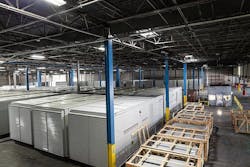As data center projects grow in scale and complexity, the value of the equipment involved has never been higher—and neither have the risks. From transformers and generators to battery systems and cooling infrastructure, the assets that power data centers are both expensive and highly sensitive to environmental conditions. But despite the value at stake, insurance is often an afterthought—until something goes wrong.
In an era of climbing premiums and intensifying environmental threats, it’s worth re-examining how mission-critical equipment is insured while in storage and transit.
The Rising Cost of Insurance
Insurance premiums for industrial and warehouse policies have surged over the past several years. The causes are multifaceted: global inflation, supply-chain volatility, and a tightening reinsurance market have all played a role. But environmental factors may be one of the most significant—and least discussed—drivers.
As data centers are being built in more geographically diverse locations, extreme weather events are occurring with greater frequency and unpredictability. Dust storms, flooding, hurricanes, and heat waves are all increasingly common—and each poses unique risks to electrical and mechanical components. Dust intrusion, for instance, can corrode circuit boards and shorten the lifespan of sensitive electrical gear. Insurers recognize this exposure and are adjusting their pricing models accordingly.
As a result, companies managing high-value storage are facing higher deductibles, stricter coverage limits, and growing scrutiny around environmental protections at storage facilities.
Understanding Who Holds the Risk
When mission-critical equipment moves through multiple hands—manufacturers, transporters, warehouses, and contractors—understanding who holds the insurance coverage at each stage becomes essential. Yet this is often one of the most misunderstood aspects of project logistics.
In most cases, coverage falls into one of two categories:
- Self-insurance or owner-procured coverage, and
- Third-party coverage through the logistics or storage provider.
Self-Insurance or Owner-Procured Coverage
In this model, the asset owner—often the equipment manufacturer, EPC, or end user—extends their existing property or inland marine coverage to include goods in transit or temporary storage. The benefit is control. The owner sets the coverage limits, defines deductibles, and can ensure that every asset, from the generator to the switchgear, aligns with their internal risk management strategy.
Because there’s no intermediary markup or administrative layering, this approach can also be more cost-effective. The trade-off is taking on full responsibility for managing coverage details internally to maintain consistency throughout transport and storage. In practice, this approach often simplifies administration, since all premiums, claims, and insurance matters are handled in-house. But for organizations with the resources to manage it, self-coverage often delivers the most transparent and comprehensive protection.
Third-Party Coverage
Alternatively, some project teams rely on the insurance policies held by their logistics or warehouse partners. For straightforward requests, this can be a convenient option—coverage may be bundled into the service rate, simplifying billing and allowing the logistics provider to manage insurance on the customer’s behalf.
However, insuring high-value or specialized equipment through a third party is rarely simple. Securing adequate coverage often requires detailed asset information, insurer approvals, and additional documentation to ensure proper protection.
In many cases, the insurance coverage in place is subject to certain limitations. For example, warehouse legal liability, riggers liability, and motor truck cargo liability policies are designed to cover the service provider’s legal exposure rather than the full insurable value of the customer’s property. These policies often impose per-occurrence or per-load limits of liability that may be lower than the aggregate value of the goods being stored, hoisted, or transported. In addition, they frequently exclude losses resulting from specific causes, including—but not limited to—natural disasters, gradual environmental deterioration, or similar events.
Striking the Right Balance
The best approach is rarely one-size-fits-all. Many large projects use a hybrid model—retaining owner coverage for high-value or sensitive equipment, while relying on the service provider’s policy for lower-value or short-term storage items. What matters most is clarity: confirming up front who carries the risk at each handoff and ensuring all policies complement rather than conflict with one another.
When these conversations happen early—before equipment ships—teams can avoid gaps, redundancies, and expensive surprises later in the project.
What Industrial and Warehouse Insurance Really Covers
Not all insurance policies are created equal. Industrial insurance and warehouse legal liability policies are designed to cover very specific risks—such as loss or damage while goods are in the care, custody, or control of a storage provider, when caused by their fault or negligence.
However, these policies usually include defined limits and exclusions, and they often do not cover certain natural disasters or indirect losses. Understanding these nuances is critical. If an item is worth several million dollars but the warehouse policy only covers up to $100,000 per occurrence, the financial exposure is substantial.
Because of this, communication between all involved parties is essential. Clear documentation of insurance terms—what’s covered, for how much, and under what conditions—helps prevent confusion and potential gaps.
Why Collaboration Matters in Insurance Planning
At BluePrint Supply Chain, we strongly encourage every customer to consult with the manufacturer, intended user, or property owner whose assets will be stored under our care, custody, or control. This ensures that no existing insurance policies are inadvertently invalidated and that each stakeholder’s coverage aligns with the project’s overall risk strategy.
Insurance providers typically discourage duplicate coverage, and coordination up front prevents claims disputes later. Aligning on this early in the project lifecycle can save time, money, and frustration if a loss event occurs.
Planning for the Unpredictable
Insurance is ultimately about preparedness. As weather patterns shift and project schedules tighten, storage conditions will play a growing role in protecting high-value assets. Projects that take the time to evaluate coverage options, clarify responsibilities, and verify environmental safeguards will be better positioned to weather both literal and financial storms.
In today’s data center landscape, risk management doesn’t stop at delivery. It begins the moment equipment leaves the factory—and continues through every mile, every warehouse, and every stage of the project.
About the Author

Joey Wagner
Joey Wagner is a Program Management Subject Matter Expert at BluePrint Supply Chain, known for applying his expertise in business development and operational strategy to drive innovative and efficient supply chain solutions for the data center industry.
BluePrint Supply Chain manages logistics, storage, and installation of mission-critical equipment for industrial construction projects. Their end-to-end approach improves visibility, streamlines communication, and ensures reliable execution from planning through installation. Learn more at BluePrint Supply Chain.



